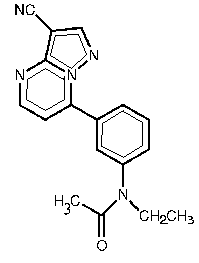Zaleplon
Zaleplon (Sonata®/Starnoc®) is a sedative/hypnotic, mainly used for insomnia. It is a nonbenzodiazepine hypnotic from the pyrazolopyrimidine class. more...
Chemistry
Zaleplon is a white to off-white powder that has very low solubility in water as well as low solubility in alcohol and propylene glycol. It has a partition coefficient in octanol/water is constant (log PC = 1.23) when the pH range is between 1 and 7.
Mode of action
Taken orally, Zaleplon reaches full concentration in approximately one hour. It is extensively metabolised, into 5-oxo-zaleplon and 5-oxo-desethylzaleplon (the latter via desethylzaleplon), with less than 1% of it excreted intact in urine.
Zaleplon interacts with the GABA receptor complex and shares some of the pharmacological properties of the benzodiazepines. Although not a benzodiazepine, Zaleplon can cause similar effects: anterograde amnesia (forgetting the period during the effects) as the most common.
Zaleplon is primarily metabolised by aldehyde oxidase, and its half-life can be affected by substances which inhibit or induce aldehyde oxidase.
Side-effects
Zaleplon may cause hallucinations, abnormal behavior, severe confusion, day-time drowsiness, dizziness or lightheadedness, unsteadiness and/or falls, double vision or other vision problems, agitation, headache, nausea, vomiting, diarrhea or abdominal pain, depression, muscle weakness, tremor, vivid or abnormal dreams and memory difficulties or amnesia.
Zaleplon is habit-forming, meaning addiction may occur. Stopping this medication suddenly after prolonged or frequent use may cause withdrawal effects such as mood changes, anxiety, and restlessness.
Read more at Wikipedia.org



